Publications
RIHN Book Series: Global Environmental Studies
This series introduces the research undertaken at, or in association with RIHN. The works published here will reflect the full breadth of RIHN scholarship in this transdisciplinary field of global environmental studies.
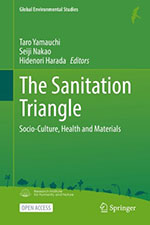
The Sanitation Triangle
Socio-Culture, Health and Materials
Edited by Taro Yamauchi, Seiji Nakao, Hidenori Harada
This open access book deals with global sanitation, where SDG 6.2 sets a target of enabling access to sanitation services for all, but has not yet been achieved in low- and middle-income countries. The transition from the United Nations MDGs to the SDGs requires more consideration based on the socio-cultural aspects of global sanitation. In other words, equitable sanitation for those in vulnerable situations could be based on socio-cultural contexts. Sanitation is a system that comprises not only a latrine but also the works for the treatment and disposal of human waste. Sanitation systems do not function by themselves but have significance only through social management. The process of decision-making also largely depends on socio-cultural conditions, and the importance of sanitation needs to be socially acknowledged. The health benefits of sanitation improvement—among the significant contributions of sanitation—also need to be considered in the socio-cultural milieu. Further, the social-culture itself is affected, and potentially even created, by sanitation. In this context, more progress on the improvement of sanitation requires a more holistic approach across disciplines.
In this book, we present the concept of the Sanitation Triangle, which considers the interconnections of health, materials, and socio-culture in sanitation, as a holistic approach, and the case studies based on the Sanitation Triangle by diverse disciplines such as Cultural Anthropology, Development Studies, Health Sciences, Engineering, and Science Communication. By the deep theoretical examinations and inter-dialogues between the different disciplines, this book explores the potentialities of inter-disciplinary studies on global sanitation.
Published by Springer,2022
264 pages, JPY 7,149(Hardcover)JPY 5,719(Softcover)
Hardcover ISBN: 978-981-16-7710-6
Softcover ISBN: 978-981-16-7713-7
eBook ISBN: 978-981-16-7711-3
DOI: https://doi.org/10.1007/978-981-16-7711-3
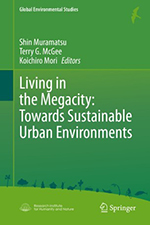
Living in the Megacity: Towards Sustainable Urban Environments
Edited by:Shin Muramatsu, Terry G. McGee, Koichiro Mori
More than half of the world's population lives in cities. World population has been growing and is expected to reach 9.3 billion in 2050. Urban population is expected to become 6.3 billion in 2050. The aggregate impact of urban population concentrated in megacities on global environment cannot be ignored, although it is sometimes said that eco-efficiency is relatively high in cities. In addition, the advent of megacities with more than ten million people is a relatively new phenomenon. Thus, our understanding of megacities has not been sufficiently accumulated to make our lifestyle there sustainable.
This book tackles the challenging issues raised by the growth of large megacities from diverse perspectives and approaches. The central question raised by the growth of megacities is what effect their growth will have on the ability of the global population to live in sustainable, livable, and safe societies. In Part I, important issues on the relationships between megacities and sustainability of the global environment are specified. Part II shows what can be learned from the history and diversity of megacities to solve challenging issues of the present. We present practical approaches that can solve the issues of megacities particularly focusing on human activities that seek the more harmonious relationship between life amenities and the natural environment: population density and urban built environment; production and trade; and environmental education and enlightenment. Part III aims to answer the question, what aspects of megacities should be measured and assessed? Barometers are necessary to control human activities in megacities. We consider how to measure and assess performances of megacities, reviewing some cases of indicators that authors have developed.
This publication highlights the challenging issues of the relationships between megacities and sustainability of the global environment and related issues that have accrued from them, based on the following three scales: long-term time scale from the past to the present and future; a vast spatial scale that links global space with local spaces; and the scale of various aspects of human socio-economic activities in megacities.
Published by Springer,2021
145,59€(Hardcover)117,69€(eBook)
ISBN (Hardcover)978-4-431-56899-5
ISBN(eBook)978-4-431-56901-5
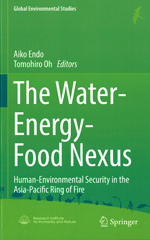
The Water-Energy-Food Nexus
Human-Environmental Security in the Asia-Pacific Ring of Fire
Edited by Endo, Aiko, Oh, Tomohiro
This book highlights the water-energy-food nexus as one of the most important and fundamental global environmental issues facing the world. Climate and social changes are putting increased pressure on water, energy and food resources. As water is the central aspect within this cluster, the book focuses on the inherent tradeoffs in water resources between producing/consuming energy and food. In addition, it discusses an inter- and trans-disciplinary approach to understanding the complexity of the water-energy-food nexus system, and creating policy options to reduce the tradeoffs among resources.
The content integrates a variety of academic disciplines, including not only the natural sciences (e.g. hydrology, coastal oceanography, costal aquatic bioscience, fisheries, environmental earth science etc.) but also the humanities and social sciences (e.g. marine policy, environmental energy policy, resource governance, policy process theory etc.). The book can be used as a textbook for undergraduate and graduate-level sustainability science courses. Further, its practical content and trans-disciplinary approach to addressing nexus issues with stakeholders offers vital information for practitioners and administrators alike.
Published by Springer,2018
159.99$(Hardcover)119.0 $(eBook)
ISBN (Hardcover)978-981-10-7382-3
ISBN(eBook)978-981-10-7383-0
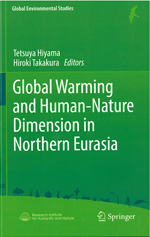
Global Warming and Human - Nature Dimension in Northern Eurasia
Edited by Hiyama, Tetsuya, Takakura, Hiroki
This book describes the current environmental changes due to global warming in northern Eurasia, especially focusing on eastern Siberia. Spring flooding, ice-jam movements, and monitoring using remote sensing are included. Additionally, current reindeer herding of indigenous peoples in Siberia and related environmental changes such as waterlogging, rising temperatures, and vegetation changes are addressed. As a summary, the book also introduces readers to adaptation strategies at several governmental levels.
The book primarily focuses on 1) introducing readers to global warming and human-nature dynamics in Siberia, with special emphasis on humidification of the region in the mid-2000s, and 2) describing social adaptation to the changing terrestrial ecosystem, with an emphasis on water environments. Adaptation strategies based on vulnerability assessments of environmental changes in northern Eurasia are crucial topics for intergovernmental organizations, such as the IPCC (Intergovernmental Panel on Climate Change). Thus, the book offers a valuable resource not only for environmental researchers but also for several stakeholders regarding global environmental change.
Published by Springer,2017
114,99 €(Hardcover)95,19 €(eBook)
ISBN 978-981-10-4647-6
ISBN(eBook)978-981-10-4648-3
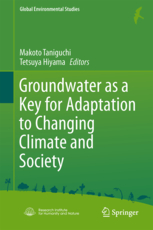
Groundwater as a Key for Adaptation to Changing Climate and Society
Edited by Taniguchi, Makoto, Hiyama, Tetsuya
This book presents an overview of recent advances in knowledge related to the assessment and management of groundwater resources, giving special attention to the uncertainties related to climate change and variability. While proposing strategies of groundwater management as adaptation, alternative, and resilience under the changing environments, this book also discusses new directions and initiatives of hydrological study, in particular on the groundwater. Groundwater is a major source of water across much of the world, and acts as a component of the global water cycle on the Earth. Groundwater has the capacity to balance large swings in precipitation, and has the potential to supplement surface-water resources when they are close to the limits of sustainability such as during drought. Although groundwater is pivotal to sustain water supplies, these important resources are vulnerable to increased human activities and the uncertain consequences of climate change. This book presents that groundwater with longer resident time of water circulation can be an alternative water resources and environment in changing climate. Assessments of groundwater services and benefit as well as risk are important for sustainable groundwater uses under the climate change. Groundwater which is one of the leys of adaptation to climate change should be treated as common resources and environment beyond the tragedy of the commons and dilemma of the boundaries.
While providing a comprehensive description of hydrogeological characteristics of groundwater systems, the present volume also covers important aspects of legal and institutional contexts required for groundwater resources management as well as social and economic considerations. This publication may contribute to an improved understanding of the impacts of climate change and human activity on groundwater resources, provides useful guidance for policy makers and planners to include groundwater into climate change adaptation schemes and strategies.
Published by Springer,2014
11,000 yen + tax
ISBN 978-4-431-54968-0
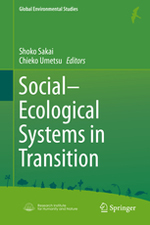
Social-Ecological Systems in Transition
Edited by Sakai, Shoko, Umetsu, Chieko
This book presents an overview of current knowledge about social–ecological systems (SESs), a productive new field dedicated to understanding the relationships between human society and nature. To make the reader aware of how SESs are necessary to maintain our society, the book begins with a broad perspective about what social–ecological systems are and what the related research issues in this field are as well. The second part discusses how human activities have changed ecosystems from temperate grasslands to tropical areas. The third part focuses on the adaptability of societies to unpredictable fluctuation in ecosystems, while the last part summarizes factors for the resilience of society against social and ecological shocks.
Human activities have severely degraded most natural ecosystems, which are now in critical condition. Various approaches have been developed to improve the SESs, to understand environmental problems and explore better ways to increase the sustainability both of ecosystems and of human societies. However, a clear perspective on how to address such problems is still lacking. Part of the difficulty arises because of the diversity and complexity of ecosystems and human societies. Another important factor is the effect of extremely rapid changes in the social and economic characteristics of social–ecological systems. Consequently, adaptability and resilience clearly are essential for the sustainability of SESs. Although there is no one, direct method to achieve high adaptability and resilience, a possible way is to compare and understand the diverse problems associated with differing social–ecological systems.
This published work makes a useful contribution to a greater understanding of the way that essential social responses linked to changes in ecosystems can potentially stimulate further research on this important and interesting subject. The book will attract the attention of scholars in environmental sciences, ecology, and sociology, and indeed of anyone interested in the concept of social–ecological systems.
Published by Springer,2014
11,000 yen + tax
ISBN 978-4-431-54910-9

The Dilemma of Boundaries
Toward a New Concept of Catchment
Edited by Taniguchi, Makoto; Shiraiwa, Takayuki
Water circulates continuously and seamlessly on Earth with little regard for the boundaries we draw. There are natural boundaries as between land and ocean and surface and subsurface environments, as well as human or demographic boundaries between nations, cultures, and religions. Although considered necessary by societies, these human-created boundaries disrupt natural water circulation, leading to serious water-related environmental problems. The dilemma of how to manage water beyond our boundaries remains, and nations have different ways and means of controlling each form of water, whether as vapor, surface water, groundwater, or seawater. Recent findings on the interaction of water from land, oceans, and the atmosphere encourage researchers to undertake collaborative work that goes beyond the boundaries of each discipline, be it oceanography, surface and subsurface hydrology, climatology, or glaciology. Drawing on all these fields, the book focuses on two major boundaries: that between surface water and ground water, and that between terrestrial water and ocean water. This comprehensive work is of great value to experts in academia, international organizations, consulting firms, water resources, fisheries, and urban development planning agencies.
Published by Springer,2012
11,000 yen (+ tax)
ISBN 978-4-431-54035-9
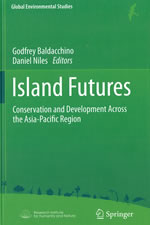
Island Futures
Conservation and Development Across the Asia-Pacific Region
Edited by Baldacchino, Godfrey; Niles, Daniel
Islands face one of the most pressing issues of our time: how to balance ecological integrity with economic development and collective quality of life, including the need for social and conservation space. Islands are sites of rich and varied human and ecological diversity, but they are also often characterized by narrow resource bases and dependency on links to the outside world, and by their limited ability to determine the actual character of those links. This volume reviews the challenges of island development and conservation in the Asia-Pacific region. With emphasis on nature reserves and UNESCO World Heritage sites, chapters describe the benefits, barriers, and potential pitfalls in preserving such sites, managing biota, and attracting and controlling tourism. The book also provides a provocative challenge to move beyond the typical concerns of “sustainability” to the more holistic concept of “futurability”, or “future potential” for convivial human–environmental interactions.
Published by Springer,2011
11,000 yen (+ tax)
ISBN 978-4-431-53989-6
▲PAGE TOP
